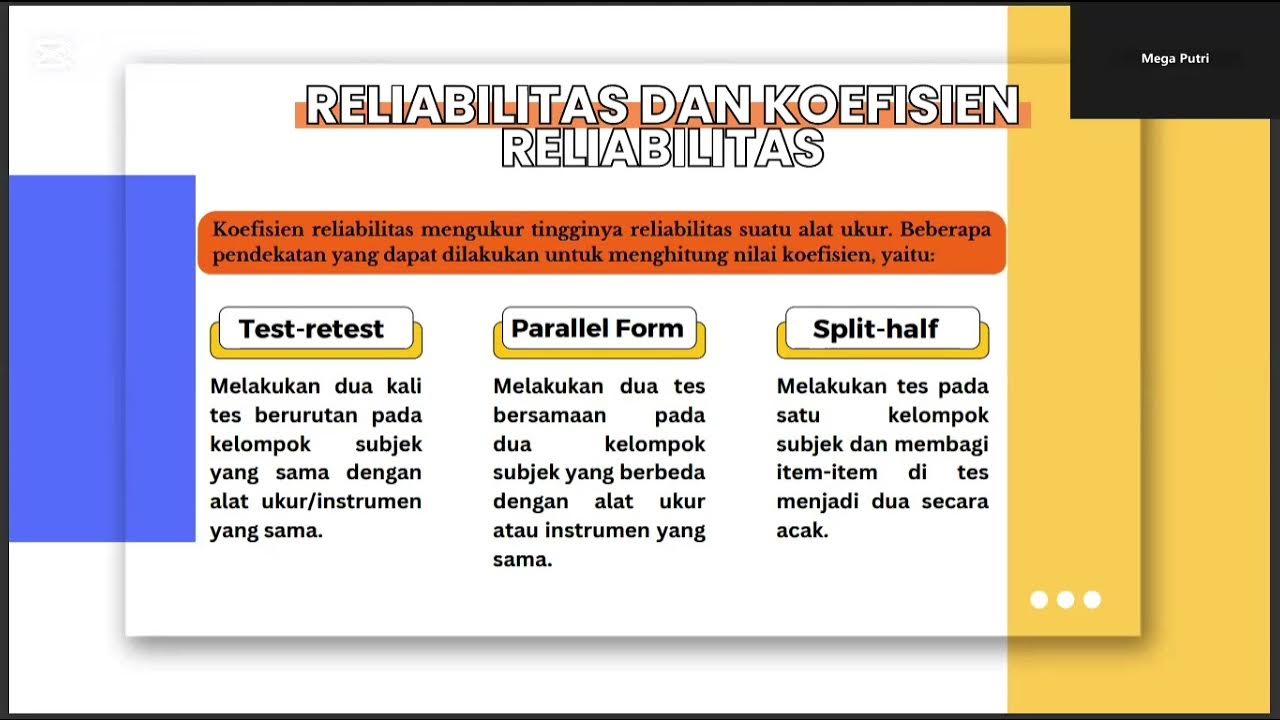Koefisien Reliabilitas Pengukuran Multidimensi
Summary
TLDRThe video discusses the use of reliability coefficients in multidimensional measurements. It starts by explaining the difference between unidimensional and multidimensional constructs, with examples such as personality traits and body measurements. The speaker highlights issues in reliability estimation, particularly when using Cronbach's Alpha in multidimensional assessments. Solutions include calculating separate reliability for each dimension or using a multidimensional reliability coefficient like stratified alpha. The speaker also demonstrates how to calculate reliability using Excel-based tools for different dimensions of a scale, showcasing the difference in results between unidimensional and multidimensional approaches.
Takeaways
- 📊 Reliability coefficients are crucial for measuring multidimensional constructs.
- 🔍 Unidimensional measurement tools assess a single attribute, with components highly correlated to each other.
- 🧠 Multidimensional constructs involve components that measure different attributes, like face and body quality, which have low correlation.
- 🧪 Applying reliability estimations like Cronbach's alpha to unidimensional data may lead to low internal consistency if the components are weakly correlated.
- 📝 Cronbach's alpha is commonly used for internal consistency, but it may not be appropriate for multidimensional measurements.
- ⚖️ For multidimensional constructs, reliability can be calculated separately for each dimension, leading to higher reliability scores.
- 💡 Strata reliability coefficients, like stratified alpha, are used for multidimensional measures to provide a single reliability score for all dimensions.
- 📉 A low correlation between dimensions (e.g., face and body) indicates that these components should be treated as separate dimensions.
- 📊 In multidimensional measurements, the use of specialized reliability coefficients like stratified alpha results in more accurate and higher reliability estimates.
- 💻 Tools like Excel-based programs can simplify the calculation of stratified reliability coefficients, leading to better insights into the multidimensional structure.
Q & A
What is the main topic of the transcript?
-The main topic of the transcript is the explanation of the use of reliability coefficients for multidimensional measurement.
What is the difference between unidimensional and multidimensional measurement?
-Unidimensional measurement refers to when a single measuring instrument measures a single attribute, whereas multidimensional measurement involves a contract where the components measure different attributes with low correlation between them.
Can you provide an example of a unidimensional construct mentioned in the transcript?
-An example of a unidimensional construct mentioned is the Entrepreneurship Personality Contract, which includes aspects like freedom, originality, creativity, and autonomy that are highly correlated.
What is the issue with applying unidimensional reliability estimation to multidimensional constructs?
-Applying unidimensional reliability estimation to multidimensional constructs can result in low reliability coefficients due to the low correlation between different components of the construct.
What is Alpha reliability coefficient and why is it significant?
-Alpha reliability coefficient is a measure of internal consistency and is significant because it indicates how well the items in a test measure a single construct.
How does the transcript suggest handling the issue of low reliability in multidimensional constructs?
-The transcript suggests applying reliability separately to each dimension or directly applying multidimensional measurement reliability to get a more accurate estimation.
What is the difference between applying Alpha to each dimension and applying multidimensional measurement reliability?
-Applying Alpha to each dimension gives you a reliability coefficient for each dimension separately, whereas multidimensional measurement reliability provides a single coefficient for all dimensions.
What is the significance of the program developed in the transcript?
-The program developed in the transcript is significant because it is an Excel-based tool that simplifies the process of estimating Alpha stratified reliability by automatically calculating the required values.
What is the minimum recommended reliability score according to the transcript?
-The transcript suggests that a reliability score of 0.7 is recommended.
How does the transcript describe the process of analyzing a multidimensional scale with three aspects?
-The transcript describes the process of analyzing a multidimensional scale with three aspects by breaking down the analysis into each dimension, calculating reliability for each, and then comparing it to the overall reliability score.
What is the outcome of using multidimensional measurement reliability versus traditional unidimensional reliability in the example provided?
-In the example, using multidimensional measurement reliability resulted in a higher reliability score of 0.78 compared to the traditional unidimensional reliability score of 0.67.
Outlines

Cette section est réservée aux utilisateurs payants. Améliorez votre compte pour accéder à cette section.
Améliorer maintenantMindmap

Cette section est réservée aux utilisateurs payants. Améliorez votre compte pour accéder à cette section.
Améliorer maintenantKeywords

Cette section est réservée aux utilisateurs payants. Améliorez votre compte pour accéder à cette section.
Améliorer maintenantHighlights

Cette section est réservée aux utilisateurs payants. Améliorez votre compte pour accéder à cette section.
Améliorer maintenantTranscripts

Cette section est réservée aux utilisateurs payants. Améliorez votre compte pour accéder à cette section.
Améliorer maintenantVoir Plus de Vidéos Connexes
5.0 / 5 (0 votes)






